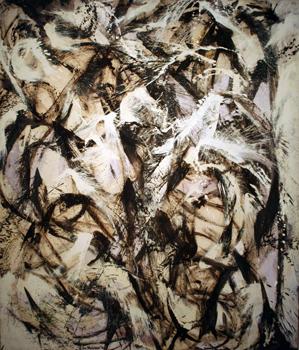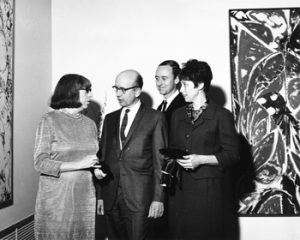Reprinted from the spring/summer 2012 issue of The Loupe
Two paintings by the renowned artist Lee Krasner (1908 – 1984) were part of the recent exhibition, Commingling Contemporary: Selections from the Permanent Collection, in the Sarah Moody Gallery of Art. The show also included an oil on paper painting by former UA art professor and nationally known abstract expressionist painter Melville Price, plus prints, paintings, drawings, quilts and other works by a range of well-known artists.

Forty-five years ago, in 1967, Krasner showed 20 of her paintings in the newly renovated “University Art Gallery” in Garland Hall. (The University Art Gallery is now known as the Sarah Moody Gallery of Art.) She was also that year’s Festival of the Arts Visiting Artist, and met with UA students in class and informally outside of class. Ron Yrabedra, BFA 1966 and MA 1967, now professor emeritus of art at Florida A&M University, remembers: “We met Lee Krasner at [department chair] Dr. Klitzke’s house. Everyone was asking her about Jackson Pollock’s work. I asked about her work and she kept me by her side from then on. She was wearing a real leopard coat and pillbox hat, and I carried her luggage across the Quadrangle.”
Krasner must have realized she had come to Alabama at a pivotal time in  history. Dr. Robert Mellown (BA 1967) remembers that while she was in town, Krasner bought and read local newspapers, to keep up with area news. The Freedom Quilting Bee had just been organized in 1966 by the Reverend Francis X. Walter, and his wife, Betty Mitchell Walter (MA 1969). Betty Walter entered the master’s program in art history and worked as gallery coordinator from 1967 through 1969. After earning her Ph.D. in art history at the University of Georgia, Walter joined the faculty of the University of North Alabama and became its first female department chair.
history. Dr. Robert Mellown (BA 1967) remembers that while she was in town, Krasner bought and read local newspapers, to keep up with area news. The Freedom Quilting Bee had just been organized in 1966 by the Reverend Francis X. Walter, and his wife, Betty Mitchell Walter (MA 1969). Betty Walter entered the master’s program in art history and worked as gallery coordinator from 1967 through 1969. After earning her Ph.D. in art history at the University of Georgia, Walter joined the faculty of the University of North Alabama and became its first female department chair.
Dr. Ted Klitzke, art department chair from 1958 to 1968, was actively involved in the Civil Rights movement on and off campus. According to Walter, Klitzke told Krasner how to find the quilters in Wilcox County. So, after visiting UA campus, Krasner made her way further south. Walter remembers that Krasner bought quilts and took them, and a freshwater mussel shell she found, back to New York, a trip that helped push the quilters and the quilting collective into the limelight.
Ron Yrabedra remembers as a student that he also helped in the quilting effort from a distance. One of his art teachers at UA, Jeri Richardson, worked to help organize the project and even lived in Wilcox County for a month. Yrabedra writes, “A lot of the quilts were backed with burlap feed sacks. Cloth and sewing materials were not easy to come by for the black quiltmakers. I can remember folding quilts in Dr. Richardson’s car and marveling at the ingenious patterns, color use, and textures — a memory that affects my own painting to this day.” Jeri Richardson went on to write her doctoral dissertation in art education (Indiana University) on the Freedom Quilting Bee collective. According to a 1969 article in the Tuscaloosa News, she said that her thesis was about “the quilting cooperative as an example of art education outside the classroom.” — Rachel Dobson
Photo captions:
top left: Lee Krasner, “White Rage,” 1961, oil on canvas, 82-1/2″ x 70-1/2, Permanent Collection. Image courtesy of the UA Dept of Art and Art History Archives. All rights reserved.
above right: Lee Krasner, Ted Klitzke, John Burnum, and Celeste Burnum at the opening reception for Krasner’s solo exhibition in Garland Hall in 1967. Image courtesy of the UA Dept of Art and Art History Archives. All rights reserved.
For more information on the Freedom Quilting Bee Collective, see:
Nancy Callahan, The Freedom Quilting Bee. 1987. Reprint, Tuscaloosa: University of Alabama Press, 2005.
Nancy Callahan, “Freedom Quilting Bee,” Encyclopedia of Alabama.